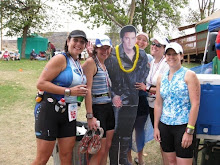by Matt Fitzgerald
November 20, 2009
Competitor Running
A new study finds that static stretching before running reduces running economy and performance.
Whether, when, and how runners should stretch are hotly debated questions lately. A new study by researchers at Florida State University may settle the specific question of whether runners should engage in static stretching (held passive stretches such as toe touches) before running. Ten trained male runners participated in the study. On separate occasions, they ran for one hour on a treadmill, beginning with 30 minutes at a moderate pace and ending with a 30-minute performance test wherein the runners were instructed to cover as much distance as possible. The runners performed 16 minutes of static stretch for the major muscle groups of the lower body before one of the runs and just sat around for 16 minutes before the other.
On average, the runners ran 3.4 percent farther in the non-stretching performance test than they ran in the post-stretching performance test. Yet while they ran farther after not stretching, they burned 5 percent fewer calories, indicating that pre-run static stretching sabotaged running performance by reducing running economy. These results were published in the Journal of Strength and Conditioning Research.
Why would a static stretching warm-up make you run less efficiently? The authors of previous studies have speculated that static stretching warm-ups temporarily reduce musculoskeletal stiffness. While the word “stiffness” generally has negative associations with respect to athletic performance, a certain type of stiffness is beneficial to running performance. When you run, your legs function as springs that repeatedly bouncing off the ground, capturing “free” energy (i.e. energy that the body does not have to generate for itself) from each impact and using it to for forward thrust. Just as a loose mechanical spring (think of a worn automobile shock absorber) is less effective than a stiffer one, a less stiff leg (resulting from laxity at key muscle-tendon junctions) bounces less effectively off the ground during running. Consequently, the leg captures less “free” energy from the round and running economy is reduced.





















No comments:
Post a Comment